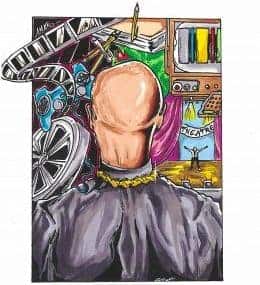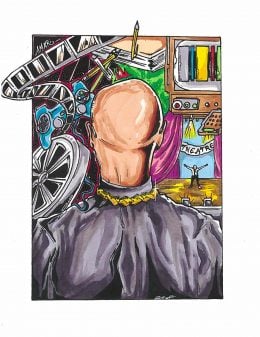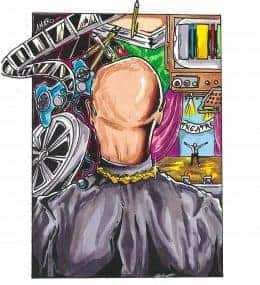Blue Is The Warmest Color – Overview/ Review (with Spoilers)
Combining the romantic chemistry of young adult novels, lack of inhibition, a story which feels like a 600-page book you can’t put down, you get Blue is the Warmest Color.

Spoiler Alert: This summary and review contains spoilers.
Additionally, some images and text may include affiliate links, meaning we may earn a commission or receive products if you make a purchase.
Combining the romantic chemistry of young adult novels, lack of inhibition, a story which feels like a 600-page book you can’t put down, you get Blue is the Warmest Color.
Review (with Spoilers)
My discovery of this movie came from it being listed amongst 12 Years a Slave as movies to watch out for after the Toronto International Film Festival. Outside of that, though, I wasn’t familiar with anyone involved. All I saw was a beautiful love story, which just so happened to feature two female leads. Of course, though, like many I’m sure, I also heard about the scenes which if cut, or edited, would easily turn this NC-17 movie into a PG-13, or light R.
Characters & Story
The story focuses on a young, doe-eyed, 17-year-old, girl named Adele (played by Adèle Exarchopoulos) who has the type of look and persona which makes her seem like someone whose life is often defined by others. Alongside her is Emma (played by Léa Seydoux) who is her opposite. Emma is a take-charge young woman who expresses her wants and desires, let’s herself be the odd one in the crowd, and to me has the type of social qualities most would want for a partner, but also the passion you would want in an ideal lover.
Their love affair, naturally, is the focus of the film, as well as the establishing of Adele as a person, and even the movie establishing French culture. Thus making it so that over the course of 3 hours you get a love story worth envy, but one which also shows human flaws. Or perhaps, better said, human vulnerability.
Praise
Perhaps the best bit of praise I can give for this film is that despite being 3 hours, you only feel it in your tailbone for sitting so long. You see, those 3 hours are truly utilized so that the romance doesn’t feel rushed, but something which naturally progressed from two curious strangers meeting eyes, to casual conversation, and then a build toward a relationship. And the main reason I like that the build is slow is because it allows everyone to be properly established. Adele gets to have a foundation made for her, which makes it so when Emma comes in, she does have something outside of their romance. For example, in the film we see Adele protest French austerity measures and talk French literature. Then, after Emma is introduced, the topics expand to French art, the topic of pleasure/sex, and each conversation strangely feels natural and not even a hint pretentious, like in The Counselor.
But perhaps one of the best things about the film is the two aforementioned actresses’ performance. Now, when it comes to the two girls, Exarchopulos gives the type of performance where you can see why she was cast, but at the same time, she is outmatched by Seydoux. In the film, while Exarchopulos is clearly established as the lead, Seydoux’s Emma quickly gets you for she shows more personality than Adele. In fact, I would consider Emma to be a 3-dimensional character who is sweet, aggressive, emotionally vulnerable, and everything you expect from a performance which is supposed to be an actual human. In comparison, Exarchopulos works Adele’s inability to define herself to create a character which isn’t lesser, but not as bold. Unfortunately, though, it makes it so as the story goes on Emma gets more of your attention and empathy than Adele, to the point Adele seems more fit to be in the supporting role.
Criticism
Which is perhaps one of the biggest issues with the film, as well as small issues with story consistency. To me, Adele slowly begins to lose the authority you expect in a lead once Emma is introduced, then the movie, unfortunately, does a time jump, of 6 years, which rids her of the foundation made by us watching her interactions with family and friends. For, and here comes the issue with consistency, they are cleanly cut from the film and never mentioned again. With that being done, Adele pretty much relies on Emma’s character like a crutch to maintain interest, or relevance, and it makes it so where you can see 20+ minutes of Adele scenes which can be cut without and real visible consequence.
The last thing to critique is the infamous sex scenes. Truly, this film blurs the lines between what can be considered art and what is pornographic, and admittedly I say this because while the sex scenes are complex in terms of them trying to show you how these two women are passionately in love, it is hard not to simply sexualize it and take away the romance. Which I solely blame on myself for this film makes you realize how American media makes violence something of the norm, but people having sexual relations, especially two women, something which perhaps can’t surpass your libido.
Yet, I must say the length and aspect of watching these sex scenes is a slight bit uncomfortable. For one, the “detail,” for a lack of a better word, is so intimate you feel like a voyeur, and then to make it worse you share this experience with other people in the theater. Thus making it where you get that pornographic feel like you are doing something indecent as if you all are at an XXX movie theater.
Overall: Worth Seeing
Truly, the only issue I had with the movie overall was that post time-jump, Adele’s character was left for dead. Outside of that, it is hard to find major issues. Thus why I believe it is worth seeing. After all, this film goes for a raw romance that doesn’t do the usual drivel where they meet, get into some stupid fight, reconcile and happily ever after. This film tries to show a woman, Adele, who is exploring her sexuality, falling in love, and somewhere between playing an expected role and trying to figure out if this role is comfortable enough to be her true self. That is why I, despite this being 3 hours and having minor consistency issues, I don’t see why this isn’t worth seeing.

